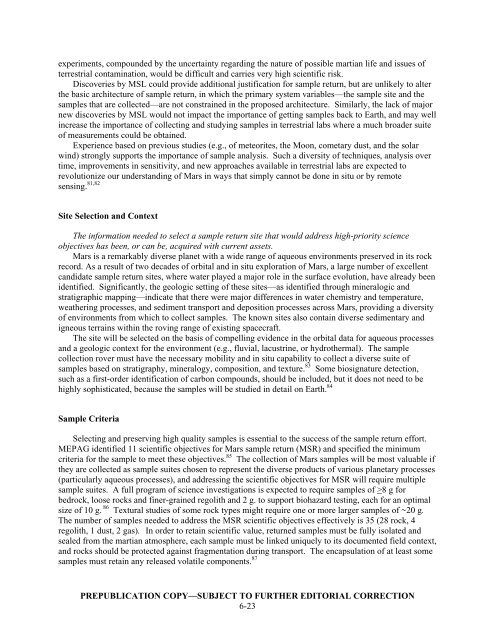Vision and Voyages for Planetary Science in the - Solar System ...
Vision and Voyages for Planetary Science in the - Solar System ...
Vision and Voyages for Planetary Science in the - Solar System ...
Create successful ePaper yourself
Turn your PDF publications into a flip-book with our unique Google optimized e-Paper software.
experiments, compounded by <strong>the</strong> uncerta<strong>in</strong>ty regard<strong>in</strong>g <strong>the</strong> nature of possible martian life <strong>and</strong> issues of<br />
terrestrial contam<strong>in</strong>ation, would be difficult <strong>and</strong> carries very high scientific risk.<br />
Discoveries by MSL could provide additional justification <strong>for</strong> sample return, but are unlikely to alter<br />
<strong>the</strong> basic architecture of sample return, <strong>in</strong> which <strong>the</strong> primary system variables—<strong>the</strong> sample site <strong>and</strong> <strong>the</strong><br />
samples that are collected—are not constra<strong>in</strong>ed <strong>in</strong> <strong>the</strong> proposed architecture. Similarly, <strong>the</strong> lack of major<br />
new discoveries by MSL would not impact <strong>the</strong> importance of gett<strong>in</strong>g samples back to Earth, <strong>and</strong> may well<br />
<strong>in</strong>crease <strong>the</strong> importance of collect<strong>in</strong>g <strong>and</strong> study<strong>in</strong>g samples <strong>in</strong> terrestrial labs where a much broader suite<br />
of measurements could be obta<strong>in</strong>ed.<br />
Experience based on previous studies (e.g., of meteorites, <strong>the</strong> Moon, cometary dust, <strong>and</strong> <strong>the</strong> solar<br />
w<strong>in</strong>d) strongly supports <strong>the</strong> importance of sample analysis. Such a diversity of techniques, analysis over<br />
time, improvements <strong>in</strong> sensitivity, <strong>and</strong> new approaches available <strong>in</strong> terrestrial labs are expected to<br />
revolutionize our underst<strong>and</strong><strong>in</strong>g of Mars <strong>in</strong> ways that simply cannot be done <strong>in</strong> situ or by remote<br />
sens<strong>in</strong>g. 81,82<br />
Site Selection <strong>and</strong> Context<br />
The <strong>in</strong><strong>for</strong>mation needed to select a sample return site that would address high-priority science<br />
objectives has been, or can be, acquired with current assets.<br />
Mars is a remarkably diverse planet with a wide range of aqueous environments preserved <strong>in</strong> its rock<br />
record. As a result of two decades of orbital <strong>and</strong> <strong>in</strong> situ exploration of Mars, a large number of excellent<br />
c<strong>and</strong>idate sample return sites, where water played a major role <strong>in</strong> <strong>the</strong> surface evolution, have already been<br />
identified. Significantly, <strong>the</strong> geologic sett<strong>in</strong>g of <strong>the</strong>se sites—as identified through m<strong>in</strong>eralogic <strong>and</strong><br />
stratigraphic mapp<strong>in</strong>g—<strong>in</strong>dicate that <strong>the</strong>re were major differences <strong>in</strong> water chemistry <strong>and</strong> temperature,<br />
wea<strong>the</strong>r<strong>in</strong>g processes, <strong>and</strong> sediment transport <strong>and</strong> deposition processes across Mars, provid<strong>in</strong>g a diversity<br />
of environments from which to collect samples. The known sites also conta<strong>in</strong> diverse sedimentary <strong>and</strong><br />
igneous terra<strong>in</strong>s with<strong>in</strong> <strong>the</strong> rov<strong>in</strong>g range of exist<strong>in</strong>g spacecraft.<br />
The site will be selected on <strong>the</strong> basis of compell<strong>in</strong>g evidence <strong>in</strong> <strong>the</strong> orbital data <strong>for</strong> aqueous processes<br />
<strong>and</strong> a geologic context <strong>for</strong> <strong>the</strong> environment (e.g., fluvial, lacustr<strong>in</strong>e, or hydro<strong>the</strong>rmal). The sample<br />
collection rover must have <strong>the</strong> necessary mobility <strong>and</strong> <strong>in</strong> situ capability to collect a diverse suite of<br />
samples based on stratigraphy, m<strong>in</strong>eralogy, composition, <strong>and</strong> texture. 83 Some biosignature detection,<br />
such as a first-order identification of carbon compounds, should be <strong>in</strong>cluded, but it does not need to be<br />
highly sophisticated, because <strong>the</strong> samples will be studied <strong>in</strong> detail on Earth. 84<br />
Sample Criteria<br />
Select<strong>in</strong>g <strong>and</strong> preserv<strong>in</strong>g high quality samples is essential to <strong>the</strong> success of <strong>the</strong> sample return ef<strong>for</strong>t.<br />
MEPAG identified 11 scientific objectives <strong>for</strong> Mars sample return (MSR) <strong>and</strong> specified <strong>the</strong> m<strong>in</strong>imum<br />
criteria <strong>for</strong> <strong>the</strong> sample to meet <strong>the</strong>se objectives. 85 The collection of Mars samples will be most valuable if<br />
<strong>the</strong>y are collected as sample suites chosen to represent <strong>the</strong> diverse products of various planetary processes<br />
(particularly aqueous processes), <strong>and</strong> address<strong>in</strong>g <strong>the</strong> scientific objectives <strong>for</strong> MSR will require multiple<br />
sample suites. A full program of science <strong>in</strong>vestigations is expected to require samples of >8 g <strong>for</strong><br />
bedrock, loose rocks <strong>and</strong> f<strong>in</strong>er-gra<strong>in</strong>ed regolith <strong>and</strong> 2 g. to support biohazard test<strong>in</strong>g, each <strong>for</strong> an optimal<br />
size of 10 g. 86 Textural studies of some rock types might require one or more larger samples of ~20 g.<br />
The number of samples needed to address <strong>the</strong> MSR scientific objectives effectively is 35 (28 rock, 4<br />
regolith, 1 dust, 2 gas). In order to reta<strong>in</strong> scientific value, returned samples must be fully isolated <strong>and</strong><br />
sealed from <strong>the</strong> martian atmosphere, each sample must be l<strong>in</strong>ked uniquely to its documented field context,<br />
<strong>and</strong> rocks should be protected aga<strong>in</strong>st fragmentation dur<strong>in</strong>g transport. The encapsulation of at least some<br />
samples must reta<strong>in</strong> any released volatile components. 87<br />
PREPUBLICATION COPY—SUBJECT TO FURTHER EDITORIAL CORRECTION<br />
6-23











